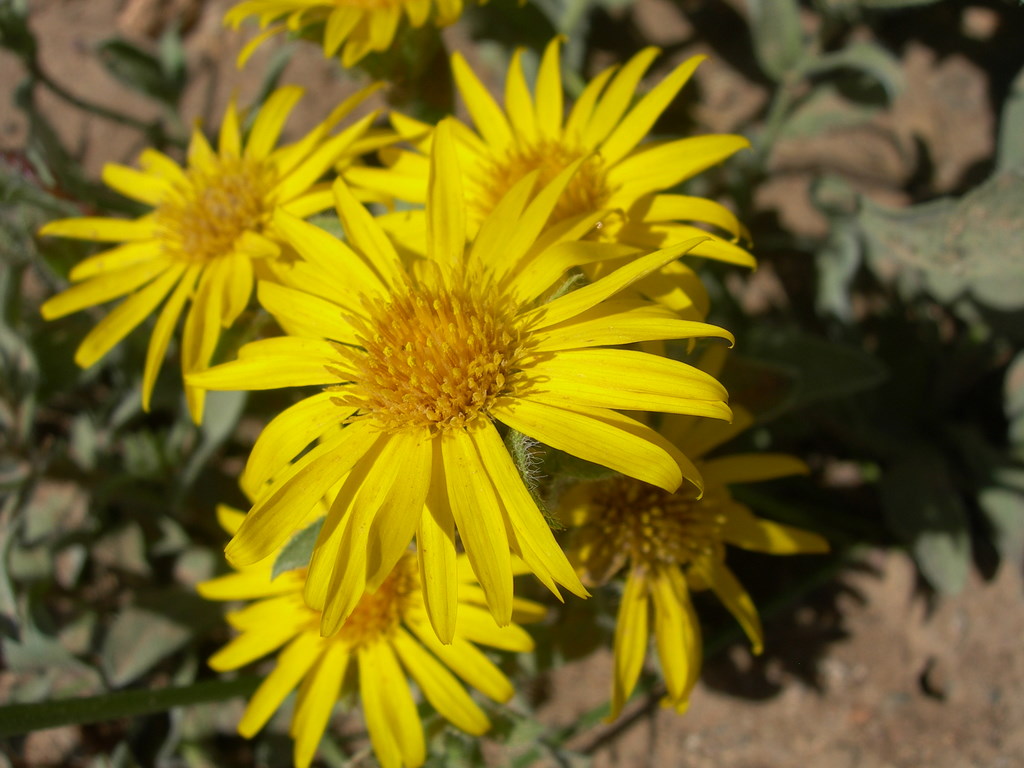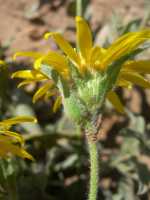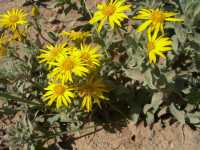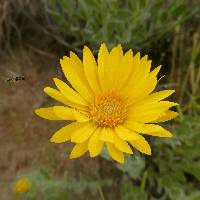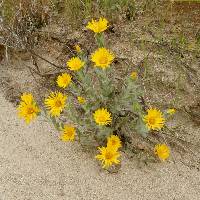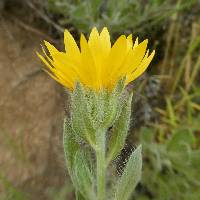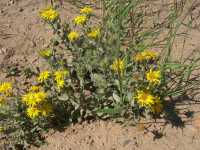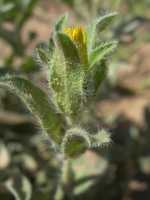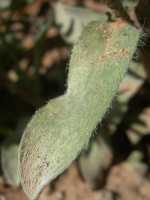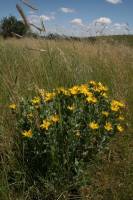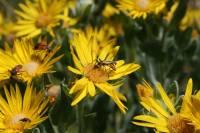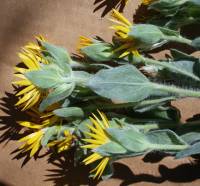Heterotheca rutteri
|
|
|
|
Family: Asteraceae
Huachuca False Golden-Aster, more...Rutter's false goldenaster
[Chrysopsis foliosa var. sericeovillosissima, moreChrysopsis rutteri (Rothrock) Greene, Chrysopsis villosa var. rutteri Rothrock] |
Perennials, 30-55 cm; taprooted. Stems 1-10+, ascending to erect (sometimes reddish brown), moderately to densely strigose, sparsely to mederately long-hirsute, sometimes proximally glabrescent with age, eglandular or sparsely stipitate-glandular beneath hairs. Leaves: proximal cauline subpetiolate to sessile, blades oblanceolate, 125-250 × 4-9 mm, bases attenuate to rounded, margins flat or weakly undulate, entire, strigoso-ciliate, a few longer hispid cilia near bases, apices acute, faces densely long-strigose (silvery white); distal sessile, blades narrowly ovate to lanceolate, 17-25 × 4.5-8.5 mm, reduced distally, bases narrowly to broadly cuneate, margins entire, large spreading hispido-strigose cilia numerous, apices sharply acute, mucronate-spinulose, faces densely long-strigose, sparsely stipitate-glandular. Heads 4-10, in open corymbiform arrays. Peduncles 10-60+ mm, strigoso-canescent, stipitate-glandular; bracts 6-10, proximal lanceolate, leafy, strigose, becoming linear, less hairy, and more glandular near heads, 1-4+ larger, lanceolate to narrowly ovate, leafy bracts (10-15 × 1.8-4.5 mm; bases sometimes attenuate to winged subpetiolate) subtending heads. Involucres cylindric to campanulate, 8.5-10.5 mm. Phyllaries in 4-5 series, lanceolate to triangular-lanceolate, unequal, scarious, moderately to densely strigose, sparsely glandular. Ray florets 15-35; laminae 12-16 × 1-2 mm. Disc florets 23-65; corollas barely ampliate, 6.5-8.3 mm, lobes 0.6-0.8 mm, lobes glabrous or sparsely hairy (0.1-0.5 mm). Cypselae monomorphic, obconic, compressed, 3-4 mm, ribs 7-10, sparsely moderately densely strigose; pappi off-white, outer of linear scales 0.5-1 mm, inner of 35-45 attenuate bristles 7-9 mm, longest attenuate. 2n = 18. Flowering (Aug-)Sep(-Oct). Grasslands with mesquite, grassy understory in oak woodlands, grassy flood plains, sandy, loamy soils; of conservation concern; 1000-1500 m; Ariz.; Mexico (Sonora). Heterotheca rutteri grows in the vicinity of the Huachuca and Santa Rita mountains of southern Arizona and adjacent Sonora, Mexico. It is distinguished by its light green to silvery white, densely hairy, narrowly ovate to lanceolate leaves, sharply acute distal leaves, and large leaflike bracts with similar (or more glandular) indument subtending the showy heads. The species is included on the BLM Sensitive Species List for Arizona.
FNA 2006, Kearney and Peebles 1969, Malusa et al. 1993, Shinners 1951 Duration: Perennial Nativity: Native Lifeform: Forb/Herb General: Herbaceous perennials, to 55 cm tall, stems 1-many, ascending to erect, sometimes reddish brown, surfaces silvery-silky, moderately to densely strigose or long-hirsute, sometimes proximally glabrescent with age, eglandular or sparsely stipitate-glandular beneath hairs, plants taprooted. Leaves: Proximal blades oblanceolate, 125-250 mm long and 4-9 mm wide, apices acute, bases attenuate to rounded, margins flat or weakly undulate, entire, surfaces strigose-ciliate, a few longer hispid cilia near bases, faces densely long-strigose and silvery white, subpetiolate to sessile, distal blades narrowly ovate to lanceolate, 17-25 mm long and 4.5-8.5 mm wide, becoming reduced distally, apices sharply acute, mucronate-spinulose, bases narrowly to broadly cuneate, margins entire, surfaces densely long-strigose, sparsely stipitate-glandular. Flowers: Heads large and showy with yellow ray and disk flowers; ray florets 15-35, laminae 12-16 mm long and 1-2 mm wide, disc florets 23-65, the corollas barely ampliate, 6.5-8.3 mm, with glabrous or sparsely hairy lobes, involucres cylindric to campanulate, 8.5-10.5 mm long, phyllaries in 4-5 series, lanceolate to triangular-lanceolate, unequal, scarious, moderately to densely strigose, sparsely glandular, flowers in 4-10 heads in open corymbiform arrays, bracts of the heads 6-10, the proximal bracts leafy, lanceolate, and strigose, becoming linear, less hairy, and more glandular near the heads, 1-4 or more bracts larger, lanceolate to narrowly ovate, surpassing heads on peduncles 10-60 mm long or more, with hairy glandular surfaces. Fruits: Cypselae monomorphic, obconic, compressed, 3-4 mm long with 7-10 ribs, these sparsely to moderately densely strigose, pappi off-white, outer pappi of linear scales 0.5-1 mm long, inner pappi of 35-45 attenuate bristles 7-9 mm, the longest attenuate. Ecology: Found on sandy, loamy soils, in grassland communities with mesquite, in grassy understories in oak woodlands, and grassy flood plains, on dry plains and mesas, of conservation concern, from 3,500-5,000 ft (1067-1524 m); flowering July-October, fruits Augu Distribution: Arizona; Mexico. Ethnobotany: Unknown, but other species in the genus have uses. Synonyms: None Editor: LCrumbacher2012 Etymology: Heterotheca is derived from the Greek heteros, "different," and theke, "ovary," from the unlike achenes of the ray and disk florets, and the meaning of rutteri is an honorific for the American botanist, so-and-so Rutter... |
|
|
|

